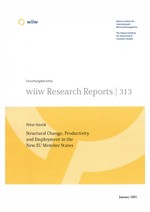Structural Change, Productivity and Employment in the New EU Member States
Peter Havlik
wiiw Research Report No. 313, January 2005
33 pages including 7 Tables and 11 Figures
This paper provides an overview of longer-term structural developments in the new EU Member States from Central and Eastern Europe (NMS). It analyses structural changes in the NMS' economies and patterns of productivity catching-up both at macro level and within the individual industries. With the transformational recession of the early 1990s left behind, the majority of the NMS embarked on a path of rapid economic growth during the past decade. They have experienced an impressive productivity catching-up, both at the macroeconomic level and in the manufacturing industry in particular. Yet in most NMS the growth of labour productivity went hand in hand with declining employment, and even with considerable job losses in the manufacturing industry. The structural changes observed during the past decade brought the NMS' economies nearer to the economic structure observed in the EU-15, but the shifts of labour among individual sectors or industries themselves did not have any marked impact on aggregate productivity growth. Similar to the EU-15, the recent productivity catching-up observed in the NMS resulted overwhelmingly from across-the-board productivity improvements in individual sectors of the economy while employment shifts among sectors had only a negligible effect on aggregate productivity growth. Notwithstanding fast productivity catching-up, the estimated productivity levels indicate that NMS are in this respect still lagging considerably behind the EU 15 economies, implying a huge catching-up potential. The estimated elasticity of employment to production growth is low in all NMS; the recently observed and expected rates of economic growth will in all likelihood not be sufficient for the creation of additional jobs. The required further productivity convergence with the EU-15 may thus be in conflict with the urgently needed employment growth in the NMS; net job creation occurred in just a few services sectors and could not offset the job losses in agriculture and industry.
Countries covered: Czech Republic, Hungary, Poland, Slovakia, Slovenia, Estonia, Latvia, Lithuania, Bulgaria, Romania
Topics: Labour and Migration; International Trade and Competitiveness; Industry
Keywords: structural change, economic growth, productivity, employment, EU enlargement
JEL classification: E24, F43, J21, J60, O11, P52
Countries covered: Bulgaria, Czechia, Estonia, Hungary, Latvia, Lithuania, Poland, Romania, Slovakia, Slovenia, Baltic States, SEE, Visegrad countries
Research Areas: Macroeconomic Analysis and Policy, Labour, Migration and Income Distribution, International Trade, Competitiveness and FDI
